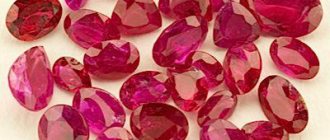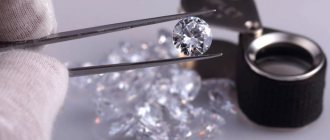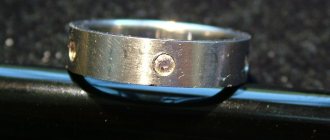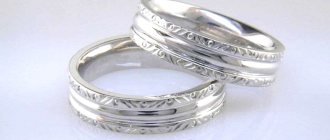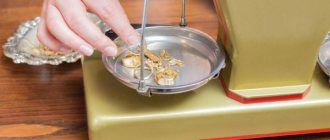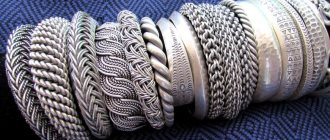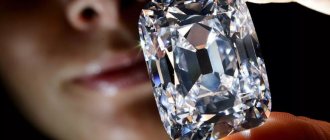How to determine whether a ruby is real or fake at home. This question is not uncommon on forums; the problem has become especially relevant since the mid-20th century, when advances in chemistry and metallurgy made it possible to grow artificial rubies on an industrial scale. It is difficult to distinguish synthetic stone from natural stone, but if you know some secrets, it is quite possible.
Properties of natural ruby
The features of this stone are unique; no mineral in the world has the same qualities as a natural ruby; experienced jewelers can very easily distinguish a fake from an original based on these features.
Hardness _ A real ruby is classified as first class in hardness, on the Mohs scale - 9. The gemstone is resistant to mechanical damage, it is difficult to leave a crack or scratch, and in its hardness it is second only to diamond.
Cut . Due to the hardness of the stone, it is very easy for jewelers to work with; an experienced craftsman can create clearly defined edges.
Color . Pink, coral, and red-burgundy rubies are found in nature. One of the most valuable rubies is bright red with a purple tint.
Shine. This mineral is characterized by a glossy shine and red highlights when illuminated.
How to identify a real ruby using a magnifying glass
- Just look at the sample through a magnifying glass. If the edges are clearly visible to the naked eye, then with magnification they can become unclear and blurry. This indicates the artificial origin of the stone.
- When looking at the stone through a magnifying glass, pay attention to inclusions in the form of bubbles. If they are the same color as the stone itself - red, then the sample is real. In artificial crystals, air bubbles are transparent.
- Pay attention to scratches on the surface of the stone, if any. Even shiny stripes indicate the unnaturalness of the sample under study. Scratches and cracks on original stones always appear in a zigzag pattern.
Natural ruby with inclusions
Types of rubies
Let's look at what types of rubies nature created.
Burmese. This species came to us from the place where rubies were mined. Specimens are found in Myanmar. It has a very bright rich red color. The stone has a high price, and just by the price you can determine whether it is a fake or not. Each cut Burmese ruby has a certificate and its own catalog number.
Ruby pigeon blood
Pigeon blood. This representative of rubies has a purple glow. Its cost is comparable to diamonds. It is practically impossible to counterfeit this type, because you will have to combine several components with metallic impurities, trying to maintain special properties.
One of the varieties is the star ruby. Many jewelers call such stones a natural miracle. It is distinguished by an internal glow that resembles a star in shape. It is almost impossible to repeat in a synthetic imitation, even for an experienced jeweler.
Ruby of natural origin is characterized by such colors as: light red, bright red, dark crimson. We can find such a rare specimen as a dark red ruby with a purple sheen.
Price and features
Ruby is the second most important gemstone after diamond. It also has high density and strength. Its edges shimmer in the light with a glow. True, not white, like diamonds, but red. It seems that you can watch these overflows forever. The cost of rubies is close, and in some samples even equal to the cost of diamonds.
Therefore, when going to a jewelry salon, you should be well prepared for your purchase. Because ruby is not very common in nature, and modern industry is not asleep. People have learned to produce artificial rubies. In addition, the thirst for profit pushes some sellers to offer other minerals, or even glass, under the guise of ruby.
Natural ruby faceted
To figure out what is offered to you in the salon, you should arm yourself with a tenfold magnifying glass and an ultraviolet flashlight. You can also bring a glass jar or glass from home.
Differences between ruby and garnet
The brilliance of garnet is significantly inferior to ruby, rubies shine like diamonds, and garnet has a muted shine; in natural light it has a matte shine. In shade it leans more towards brown. Garnet has the property of magnetization, which ruby does not have.
Ring with garnet
Differences from tourmaline
Tourmalines are very similar to rubies; in particular, light red and pink rubies are counterfeited with tourmaline. Jewelry craftsmen identify such counterfeits in the following way: they illuminate the mineral with ultraviolet light. When exposed to ultraviolet light, the ruby remains red, and the tourmaline changes its color to an orange sheen.
Noble spinel
For a long time, it was difficult for jewelers to distinguish a ruby from a noble spinel. But today it is known that spinel is an oxide of magnesium and aluminum, and ruby is an aluminum oxide, the red color of both minerals is due to the presence of chromium in the composition.
Light to the rescue
In the event that you don’t have a magnifying glass at hand, and the store salesperson refuses to provide it, casting doubts about the authenticity of the product, you can try playing with light.
Natural stone, exposed to the rays of sunlight, will reveal all its incredible beauty. The side that is illuminated by the sun will exude an amazing burgundy shine. On the reverse side, the surface will remain matte with a pale glow.
If you have an ultraviolet flashlight with a wavelength of 280 nm at your disposal, then you can dedicate it to the ruby. The original stone will not change the color of the glow, it will remain red. The imitation will sparkle with orange tones when exposed to ultraviolet light.
The “pigeon’s blood” effect, characteristic of real rubies, is clearly visible when the product is turned in different directions in daylight. The gem shimmers with purple hues. Imitation material does not have this effect.
For reliable results, you can use two testing methods simultaneously - viewing the sample through a magnifying glass and in sunlight.
Is corundum a ruby or not?
Let's take a little look at corundum and ruby - they have a number of similar properties. People may even think that the differences between these stones are very insignificant. Both minerals are considered to have high strength, characteristic luster, and are resistant to chemical attack.
Corundum is mined in the USA, India, Greece, Sri Lanka, Madagascar, Tanzania, Russia, Norway, Ceylon, and Canada. Corundum has one of the highest forms of density and hardness, and is in no way inferior to ruby. The color range that is characteristic of corundum:
red, black, green, pink, white, and this is the first difference from ruby. Such a wide color palette of the mineral distinguishes it from ruby.
A little history
Ruby gained fame in ancient India, where it was considered the king of precious stones.
The Greeks and Romans also highly valued ruby and believed that the stone promoted victories and great feats, so the palaces of rulers and their clothes were often decorated with ruby items. In eastern countries, the stone personified vital energy, and its owners received love, strength and health. In Rus', the gem became popular in the 9th century and was called yakhont (like its “brother” sapphire). It was believed that the stone gives strength and heals the heart. And since “yakhontovy” used to be a synonym for “precious”, the expression “you are my yakhontovy” was adopted among the people as an address to a dear, beloved person. Photos of the ruby stone demonstrate its unsurpassed majesty and mystery.
How are rubies counterfeited in the modern world?
In 1857, the French chemist Marc Gaudin managed to obtain an artificial stone through synthesis; he fused two salts - alum and potassium chromate, obtaining ruby crystals.
In 1896, French scientist Auguste Verneuil grew the first synthetic minerals. He made a specialized furnace with a hydrogen-oxygen burner for the synthesis of rubies. This method began to gain popularity, and the era of industrial production of synthetic jewelry stones began, which immediately swept across Europe.
Does an artificial mineral have healing and magical properties?
Natural ruby is valued not only for its beauty, but also for its magical properties, including attracting wealth and good luck in love, helping to wisely lead people. The healing effect of the mineral is also high.
Another thing is imitation ruby. There is no magical energy in glass or plastic, in crystals grown from salt or sugar.
The properties of a composite ruby, that is, an alloy of glass and a real ruby component, allow us to talk about its effect on the owner. However, this effect is less pronounced than the influence of a natural gem.
Artificial stone, that is, grown in laboratory conditions, has more modest healing and magical properties. Although disputes on this matter do not stop.
Modern methods of producing synthetic stones
Verneuil's method. This method is carried out by melting a charge; in the case of ruby, the charge is a mixture of aluminum and chromium oxides. The furnace has a technology so that in a flow of oxygen the charge falls down, falling into the combustion chamber where hydrogen is supplied and where the burner is located.
A melting process occurs, and the resulting droplet falls on a ceramic substrate, on which a boule is formed, with a diameter of 2 cm and a length of up to 5-10 cm. More than 100 types of crystals have been developed to date using this method.
Czochralski method
Czochralski method. It is a method of producing crystals of very high quality. This method allows you to obtain rubies, which are a quality material for jewelers.
Zone melting
The method is technologically simple. A mixture of the previously calcined oxides of the main components with impurities and a seed is placed in a molybdenum boat, which is slowly pulled along the heater. As the boat moves, a narrow zone appears in the charge, which, with further movement, solidifies to form a single crystal. The resulting crystal measures approximately 8 cm, height 2 cm, length 18 cm.
Method of garnissage melting. The material is melted and crystallizes within its own cold zones. When cooled, columnar crystals form.
Hydrometric synthesis method. This process is carried out by crystallization of the mineral in solutions of low-melting compounds (lead, boron and other elements).
How to identify a real ruby at home
When purchasing jewelry with a red stone, you need to make sure of its authenticity. Of course, no one can check this kind of work better than an experienced jeweler. But if you can’t contact a knowledgeable technician, you can check it yourself.
Methods for synthesizing artificial crystals
In the mid-twentieth century, rubies grown synthetically began to appear on the jewelry market. Synthetic stones are visually almost no different from their analogues. Obtained by growing a single crystal from corundum.
Modern technologies make it possible to “grow” rubies with properties close to the original. Synthetic stones have ideal transparency, large size and almost complete absence of cracks. But an experienced jeweler can easily distinguish a stone of natural origin from a synthetic one.
Today, artificial rubies are produced using four methods:
- Czochralski;
- Vernel;
- flux;
- hydrothermal.
The most advanced methods are Czochralski and Vernel. By the way, the French scientist Vernel was the first who managed to grow synthetic ruby. Using these methods you can obtain the largest and cheapest stones. Minerals grown using these methods are distinguished by their curved growth lines.
Flux and hydrothermal methods are very expensive, but with their help it is possible to grow the most perfect rubies. Often, even experienced jewelers can hardly tell by eye what is a natural stone and what is synthetic. Therefore, when purchasing a large specimen, just in case, it is better to consult an experienced gemologist.
Effective Methods for Testing Natural Ruby
One of the simple and quick methods is to place the stone on a closed eyelid; the fake one heats up immediately, but the natural ruby remains cold, as it is a poor heat conductor.
Take the mineral in your hands in natural light, pointing it towards the sun; the side facing the sun will shine and shimmer, while the opposite side will remain dull. If you see this, then this is a real mineral.
Test in liquid
Place the jewelry in an empty glass container. If pale red radiation appears, then this is a real ruby. You cannot see such a glow from an artificial sample.
This method, of course, raises doubts, but it is worth mentioning. If you place a real ruby in a container of homemade milk, the liquid will acquire a characteristic pink tint.
Under ultraviolet light, a genuine ruby remains red, while a fake ruby turns orange.
How to check the authenticity of a breed at home
If you want to know more about a stone that has already been purchased and is at your disposal, you can try to check its authenticity yourself, at home. There are several ways to do this.
- Option one. Prepare any glass container. It doesn’t matter what volume and shape it will have, the main thing is the transparent walls. Place the pebble in the bowl. If it is a real ruby, regardless of the carat, it will glow with beautiful red rays. A fake does not have this effect.
- Method two. Examine the pebble in the light (natural lighting is a must). If this is a real ruby, then in the sun it will sparkle with different shades depending on the degree of lighting. Opposite the sun, the mineral will glow burgundy, and on the other side it will glow with a pale and matte light.
- The third method is using milk. A ruby is placed in a glass of milk. If it changes color to pink, then the gem is real. And the point here is not in chemistry, but in the optical effect - the stone glows so brightly that the illusion of coloring the milk is created.
- The fourth method is exposure to ultraviolet light. The synthetic analogue will remain red under UV rays, while the genuine samples will take on a warm orange tint.
- The fifth method is to study the internal component. In fake and real stones you can see bubbles inside, but in the former they are filled with air, and in the latter they are filled with gases.
- Method six - strength test. If you try to scratch the surface of a ruby with glass, the scratches will come out uneven. In imitations, damage of this kind is usually straight and glossy.
- Method seven - heating. Natural rubies heat up very slowly. It is easy to feel if you hold the stone in your palm. Imitations quickly absorb the heat of the human body. By this feature they can be easily distinguished from the original.
The weight of the mineral is another important property to pay attention to. Original breeds are always noticeably heavier than fakes, harder and more solid.
Useful information about rubies
To avoid falling for the tricks of scammers who offer to buy natural rubies at an affordable price, remember the uniqueness of the gemstone. Before concluding a transaction, be guided by the following facts:
- The cost of a high-quality bright red ruby starts at $10,000 per 1 carat. Such minerals are mined in quarries in Burma and are not supplied to jewelry stores, but are sold exclusively at auctions.
- Souvenirs are not made from expensive crystals; the stones are used only in the production of jewelry.
- For 50 years now, there have been no jewelry made from natural rubies in jewelry stores on the international market. The amount of red minerals remaining in the world determines their uniqueness and determines the price of the crystals.
- Antique stones of a dark burgundy hue from the oxide class, made before the 19th century, are a priori genuine. Jewelry with rubies was intended only for high-ranking officials and royalty, so jewelers did not even think about counterfeiting crystals.
Faceted rubies are edged with precious metals or set into tiaras, crowns and wands. Rings, earrings, necklaces and amulets with compact-sized gemstones are offered at auctions.
Only a gemologist after an examination can distinguish a natural stone from a skillfully cut fake grown in specially created conditions - visually the crystals are identical
Knowing how to determine the authenticity of a ruby, you don’t have to worry about the natural origin of the product. The main thing is not to forget to use useful information before purchasing a gemstone.
Ruby and sapphire jewelry
The fashion for ruby and sapphire jewelry has remained unchanged for many centuries. Gems are widely used in jewelry and are part of all kinds of products: earrings, rings, bracelets, necklaces, etc. Young ladies should not have a question about what looks more expensive – a ruby or a sapphire. Both gems are stones of the highest order and a magnificent addition to the wardrobe of fashionistas. Ruby goes well with gold - white and yellow, as well as silver. Photos of jewelry with ruby stone confirm this.
Sapphire looks best with silver or white gold. The abundance of different options allows you to choose jewelry for both everyday wear and special occasions.
Photos of gold jewelry with a sapphire stone indicate that the gem is in perfect harmony with white gold. No woman will refuse such jewelry!
Ruby and Zodiac signs
Astrologers call ruby a stone of happiness and warmth of the heart, but due to its magical properties it is not suitable for all people according to their zodiac sign.
An energetically powerful mineral associated with the element of Fire has low zodiacal compatibility with the signs of Water and Earth. Change
| Zodiac sign | Compatibility (“+++” – ideal, “++” – good, “+” – acceptable, “–” – prohibited to wear) | Influence on the representative of the sign |
| Aries | ++ | makes you brave and kind-hearted |
| Taurus | — | the energy of the stone is categorically incompatible with the energy of the sign’s representative |
| Twins | + | eliminates duplicity, makes you treat the people around you with great attention and care |
| Cancer | +++ | increases self-confidence, thanks to which it is possible to achieve significant heights in life, brings the meeting with your soulmate closer |
| a lion | ++ | increases determination, helps to successfully complete started tasks |
| Virgo | — | the energy of the mineral conflicts with the energy of the representative of the sign |
| Scales | + | gives the ability to quickly make the right decisions, eliminates doubts |
| Scorpion | + | makes the character softer, more compliant |
| Sagittarius | +++ | makes love relationships passionate and bright, and in marital relationships helps to remain faithful |
| Capricorn | + | makes the character softer, more pliable, caring, eliminates callousness and excessive pragmatism |
| Aquarius | + | makes character strong, strong-willed, decisive |
| Fish | + | the mineral should be worn with caution, as it can enhance negative character traits |
A real ruby is very expensive! What are you giving me here?!
Many people who want to purchase precious stones and products with them are very distrustful of relatively low prices and, even more so, are afraid of overpaying a round sum for a fake. And it is right!
In this article, I want to highlight the topic of purchasing rubies and share with you knowledge on how you can protect yourself from a purchase that does not meet your expectations.
Imitations, synthetics and other troubles.
It is very difficult for the average person to distinguish natural stone even from glass, and even more so from high-quality synthetics.
Why am I writing about synthetics and not using the term “imitation”?
Because imitation is a fake of something when other materials imitate the original in appearance.
Synthetics, on the other hand, are not an imitation, because they are completely identical to the original and have the same chemical composition and physical properties.
glass can be an imitation of ruby . But, when compared externally with a natural mineral, it is clear that it has an unnaturally uniform rich color and a “cheap” shine. All the highlights of the edges will be the same shade (which is also typical for synthetics). Glass is much lighter and softer than ruby.
Glass is still rarely passed off as large natural stones, but you need to be careful with small sprinkles! With a stone size of 1-2mm, it is difficult to determine its naturalness from a photo. In this case, you need to pay attention to whether the shades of the stones are different. Natural stones will not be exactly the same color and saturation.
More often, other semi-precious stones, such as garnet and red tourmaline, are passed off as rubies.
However, this is not always beneficial, because... high-quality red tourmaline, rare types of garnet, as well as natural ruby spinel will cost more than glass-filled ruby (information about this type of refining of natural stones will be given below).
All of these stones have a lower hardness (on the Mohs scale) and different numerical indices of light refraction (determined by a refractometer) than ruby.
Of course, it is impossible to determine all this from a photo, but, with a certain “observation,” it is possible to distinguish them from rubies by color, shine and inclusions.
The photo below, for example, shows rubellite tourmaline (unlike ruby, it does not fluoresce) and pyrope garnet (can be confused with brownish, iron-rich Thai ruby, but, unlike it, has a homogeneous structure).
The situation is more complicated with synthetic ruby . In its composition and properties it is completely identical to natural stone.
And if the synthetics of the “pre-Soviet” and “Soviet” periods are stones of ideal purity that are easy to identify by their price, because... natural rubies of similar quality cost thousands of dollars per carat (all pink and red rubies in jewelry from the times of the USSR are synthetic!), but modern synthetics will be more difficult to distinguish “by eye”.
Modern methods of production and subsequent refining of rubies make it possible to create inclusions in the stone, which for many serve as an indicator of the naturalness of the stone.
You can try to distinguish Chinese and Indian imitations, as well as modern synthetics with inclusions, from the photo if the seller provides you with it of good quality.
Of course, the average person will not be able to distinguish flux inclusions in a synthetic ruby from gas-liquid inclusions in a natural stone, even with a magnifying glass, let alone a photo. But some obvious signs are often immediately visible.
Ruby is synthetic or imitation (often colored quartz) if:
1- all inclusions in the stone are of the same shape and color and are evenly distributed in the space of the stone
2- inclusions are clusters of transparent small bubbles in the form of waves, intertwined and reminiscent of puffs of smoke
3- the filler of the cracks of the stone is darker than its main color (in natural sapphires refined with glass filling, this is possible, in rubies - not, unless it is colorless corundum culling impregnated with dye).
4- the stone has ideal purity and rich color
5- all inclusions in the stone are of the same light color (when viewed through a magnifying glass, such inclusions will appear as small transparent bubbles), while the main color of the stone is uniform, without halftones.
6- the stone has internal cracks in the form of a large mesh
Below you can see photos of such stones.
Colored quartz or corundum. The accumulation of dye in the cracks is visible.
Inclusions that look like waves or puffs of smoke
White fluid inclusions in hydrothermally grown synthetic ruby
There are no inclusions in the stone, all highlights of the stone are of the same shade
Internal cracks in the form of a mesh (honeycomb)
So what are they then, NATURAL rubies?
And why are they so cheap? Is there some kind of catch?
Yes and no…
Rubies have four main quality indicators: color, clarity, weight, and cut quality.
Unlike diamonds, color is the determining factor.
Defect groups for rubies can easily be found on the Internet.
But, if we are talking about buying a ruby, the price tag of which is “x” thousand rubles, and not dollars, then it is not worth delving into these indicators..
In addition to the characteristics of the stone listed above, its cost is greatly influenced by the method of its refining. Or rather, it doesn’t even affect, but divides it into three categories:
1- Rubies N - unrefined faceted stones (rare, but can be found on the open market with low quality indicators)
2- Rubies H - stones refined by heat (stones are heated to high temperatures to enhance color, due to the dissolution of internal inclusions, and purity)
3- Rubies F - glass-filled rubies (stones that are initially pale and fractured are heated in a mass of glassy substances that seal the cracks and pores)
So it is the third type of rubies that is found on store shelves in 99% of cases! And it is precisely such stones that can cost thousands and even hundreds of rubles, not dollars!
It turns out that’s where the catch is! Stones are half glass, they are short-lived and fragile!
— These exclamations can be seen on many websites and forums. Some “experts” claim that such a ruby will fall apart even if you swim with it in sea water...
But is everything so pessimistic?
Let's not believe unfounded statements, but let's understand the physics of the process.
Debunking myths and judgments.
It is believed that rubies that are “annealed for color” do not contain any glassy substances in the cracks and pores.
This is actually a false statement! Because all stones are annealed in a liquid flux and gas environment, the components of which can form glassy compounds, microdefects in the crystals are filled with this mass. Therefore, the division of rubies into “only heated” and “filled with glass” is very arbitrary and rather a marketing ploy.
The question is the percentage of this “glass” in the stone. This is what determines the quality and cost of category F rubies.
If there is a lot of “glass” in a ruby (more correctly, lead oxide), then such stones have a high concentration of cracks and other defects, they are cloudy and do not have an internal shine.
But if the stone is sufficiently transparent, the internal edges reflect light rays and the cracks are not noticeable to the naked eye, then such a ruby is considered high quality in its category and is not inferior in appearance to H and even N rubies and its price will not be “budgetary”.
Regarding strength, the process of healing cracks is irreversible. The stone will not crack, will not deteriorate from sea water, and will not fade in the sun. Unless, of course, you hit it with a hammer, throw it into the fire and pour acid on it, then it will delight you for many decades.
I would like to note that when taking a bath, house cleaning and other activities that bring your jewelry into contact with an aggressive chemical environment, it is better to remove any jewelry, regardless of the type of stone enhancement.
Now all that remains is to deal with the inclusions in natural rubies in order to distinguish them from fakes.
Inclusions and microdefects in natural rubies.
Natural rubies can be identified from photographs by the following characteristics:
1- the color in the space of natural stone is distributed unevenly due to microdefects
2- the inner edges of the stone, when light hits them, will have highlights of different color tones
3- defects in natural stones are heterogeneous and more often have a linear orientation, internal stresses are similar to brush strokes or fibers, but never form a continuous diamond-shaped lattice
4- the color of inclusions can be red (iron impurities), black (graphite), dark red, brown
5- inclusions can be in the form of streaks on the glass and fingerprints, but never in the form of white round bubbles.
6- the space of heated and glass-filled rubies is similar to fruit jelly with many bubbles (bubbles are formed in the crack filler, they are always dark in color, matching the stone), flakes, zigzag cracks, clouds of “red cotton wool”
7- microdefects are imperfect and unevenly distributed inside the crystal
Below are photos of natural stones with various types of enhancement
Unrefined ruby N with undissolved natural inclusions. Inhomogeneity of color is visible.
Ruby N with zigzag internal crack
Ruby N with parallel oriented internal cracks
Ruby F. The photo shows bubbles of various shapes, flakes and “red cotton wool”
Ruby F cabochon is of low quality, opaque. Parallel stripes of inclusions, flakes, and bubbles are visible.
Ruby F. good quality. Minimum cracks and inclusions. Flakes and “red cotton wool” are visible
Bright heated ruby F. A network of microcracks is visible on the surface.
Ruby graded H. Heated with no signs of glass filling.
The surface of such rubies is smooth, without a network of microcracks.
In the article I did not touch on the topic of “star” rubies. I can briefly say that they have now learned how to make a “star” in synthetic corundum. And you need to be careful with stones with a rich, uniform color and a bright, perfectly even star.
I hope the information presented will help you navigate the many available options for jewelry with rubies and protect you from buying fakes.
Add to favorites so you don't lose!
PS: I tried to present all the information in the most accessible form for the buyer, please do not throw professional gemologists at me.
Mining rubies - when will nature run out of stones?
Mining such stones is not an easy task; rubies are found in rock layers at considerable depth, and ruby deposits are gradually decreasing. Scientists have calculated. That in a thousand years a person will extract the last natural stone from the depths.
The highest quality and most expensive rubies are mined in Myanmar (formerly Burma); stones from this deposit are also called “pigeon blood” because, in addition to their blood-red color, they have a purple tint. Pigeon blood is also found in Vietnam.
The city of Mong Shu in India also boasts exceptional rubies, most of which are black with red edges. They are often even more expensive than pigeon blood because they are extremely rare. Almost the entire population of the city is engaged in crystal mining.
Each deposit produces its own stone, which varies in shade; the third largest deposit is in Ceylon, where rubies of a unique coral color are mined. Although they are not as sought after as blood red, their price is also high.
However, recent studies have shown that even in these layers very few crystals remain. The last stone will be mined soon, which may indicate a further increase in the price of this unique mineral.
How is stone grown?
Synthetic rubies were first produced in France. In 1892, Auguste Verneuil proposed a method of growing rubies from aluminum oxide and small admixtures of other metals to give a characteristic color. During production, the components are melted in the fire of a hydrogen-oxygen burner, and the flowing drops form a mineral weighing up to 30 carats in a few hours.
The scientist’s idea became the basis for the development of technologies for growing other precious stones. Rubies grown by “pulling” single crystals from a melt (Czochralski method), crystallization from the gas phase, hydrothermal method, etc. are used on an industrial scale. Today, the method of growing rubies using nanotechnology is gaining popularity.
The production of artificial rubies takes place in a chemical laboratory or production environment, which, of course, cannot be achieved at home. At home, as a gift, you can grow ruby from potassium hexacyanoferrate (III). To create such an “artificial ruby”, you need:
- bring 350 ml of water to a boil, then remove from the stove and cool to 90–95 degrees;
- dissolve 200 g of potassium hexacyanoferrate (III) in hot water;
- lower a small pebble to the bottom, close and put the container with the solution in a dark place for 2-3 weeks.
During this time, a “ruby” stalagmite will “grow” on the pebble. It is important that the liquid completely covers the formation. As soon as the “synthetic ruby” begins to rise above the level of the solution, you need to remove it and dry it. Potassium hexacyanoferrate (III) is a toxic substance, so when working with it you must use protective equipment (respirator, gloves, apron and safety glasses).
